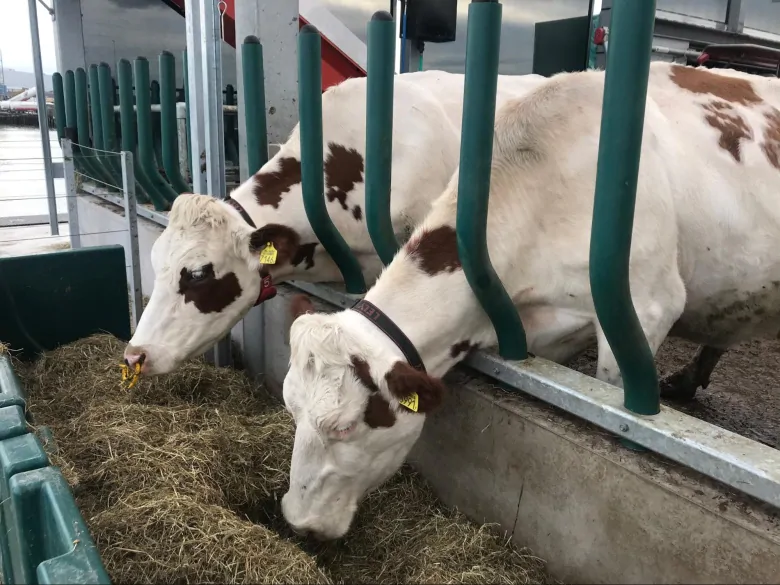World's 1st floating dairy farm could help cities adapt to climate change

As you approach the Port of Rotterdam, Europe’s largest, the usual sights come into focus: cranes, barges, shipping containers, seagulls. But down a busy industrial road toward the water, something surprising appears on the horizon: cows.
Thirty-five Dutch Meuse-Rhine-Issel cows, to be exact.
“Because of global warming, the world is sinking and shrinking,” said Peter van Wingerden, owner and CEO of Floating Farm, the world’s first floating dairy farm.
“Being in the port, we came up with this idea to build a farm on water, so we could bring healthy food close to consumers, who are increasingly moving to cities.”
The UN estimates that the global population is expected to rise from today’s 7.7 billion to 9.7 billion by 2050, with 68 per cent of people living in urban areas.
In a country where land is in short supply and where some areas are sinking a few millimetres each year, turning to the water made perfect sense for a new kind of urban farming that is circular, self-sufficient and sustainable — what Floating Farm calls “transfarmation.”
The idea is to give cities the ability to feed themselves, making them less reliant on on the transportation links needed to import food, which are increasingly vulnerable to being disrupted by extreme weather linked to climate change.
Van Wingerden’s climate-adaptive farm can move with the water, no matter how much rain falls or how high sea levels rise, he said.

His floating farm is a three-storey structure, where the bottom floor is below sea level. The cows live on the top floor, but can wander down a ramp onto a field on the shore next to their floating home. They feed on discarded grass clippings from local fields and golf courses, as well as potato peels and their favourite beer broth from local breweries.
The manure they produce is then used to fertilize local parks and playing fields, including the pitch for one of Rotterdam’s professional soccer teams, Feyenoord.
“Cows are the ultimate biomass upcycle machine,” said van Wingerden. “Ours is a circular process going from cow to city to cow.”
Farm run with 2 humans, 3 robots
While the cow themselves may be decidedly low-tech, the farm itself is anything but. It makes use of three types of robots: one for milking, one for feeding and one that functions as a pooper scooper.
“The entire process is completely automated,” said van Wingerden, who employs only two farmers. “What we are trying to do here is produce the highest yield of food with less people.”

The floating farm, which opened in May, is more than just a farm — it’s also a processing plant. On the second floor, the 700 litres of raw milk the cows produce per day is pasteurized and some is processed into yogurt. The milk and yogurt is sold locally under the Made in 010 label, a nod to the city’s area code.
It costs van Wingerden more to produce the milk than the farm could sell it for wholesale to a processor. But doing its own processing allows this private venture to break even.
“It has to be a viable business model or it couldn’t be replicated elsewhere,” said van Wingerden.
Cities worldwide, including New York and Shanghai, are already interested in the concept. He said it could also work for countries like Bangladesh (which already has its own floating vegetable farms) and Singapore, which are small but surrounded by water.
The farm can be scaled up by adding more floors or expanding its area.
“We need to feed the world and its increasing population, and that can’t be done by rural areas,” van Wingerden said. “So let’s enjoy rural life, but let’s produce food on a technical basis in a different way.”
Bad for the cows?
That’s a ludicrous argument, according to Jeroen van Maanen, a spokesperson for the advocacy group Farmers Defence Force, which has spearheaded recent pro-farming demonstrations in the Netherlands.
“I don’t see the benefit,” he said. “There is plenty of agricultural land. It’s good to bring consumers closer to producers, but there are easier ways to do it than by putting cows on the sea.”
Cows need the vast space that traditional pastures provide, van Maanen said. But many modern farms raise their animals entirely indoors, and Floating Farms said its cows get more space than “regular stables” offer.
Van Maanen said he doesn’t see the difference between the floating farm and conventional industrial farming.

For futurist Gerd Leonhard, the future of farming lies somewhere in between: good old-fashioned farming combined with vertical farming, AI, robots and food grown in labs.
“I think agriculture and food will always entail human effort. But how are we going to feed 10 billion people?” he says. “Digital agriculture is clearly a solution.”
Leonhard acknowledged the idea is way too expensive now, but pointed at how other technologies, such as music streaming, have evolved.
“What was really expensive a few years ago becomes the new normal,” he said, likening digital agriculture to “Spotify for food.”
As for van Wingerden, he’s ploughing into that future. Next up?
“A floating egg farm with chickens. And after that, a vegetable farm. All on the water, of course.”





